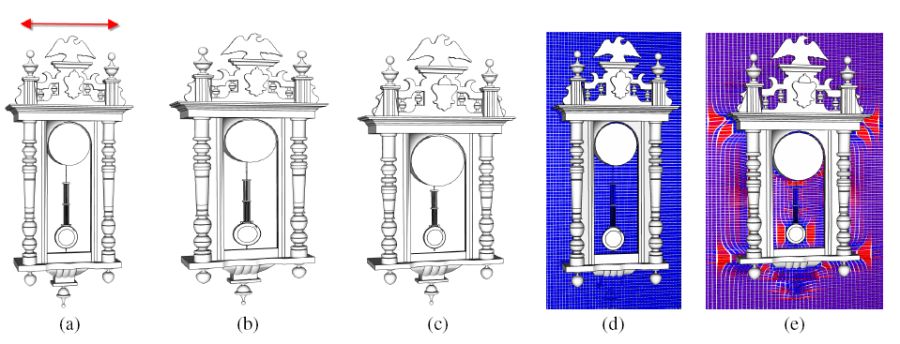
Non-homogeneous Resizing of Complex Models
Vladislav Kraevoy Alla Sheffer Daniel Cohen-Or Ariel Shamir

Resizing a clock model: Standard
non-uniform scale distorts the shape of parts of the model, e.g. the dial (b).
Our approach resizes the clock in a more natural manner protecting its shape
(c).
(d) and (e) show part of the
protective grid before and after resizing.
|
Abstract Resizing of 3D models can be very useful when creating new models or placing models inside different scenes. However, uniform scaling is limited in its applicability while straightforward non-uniform scaling can destroy features and lead to serious visual artifacts. Our goal is to define a method that protects model features and structures during resizing. We observe that typically, during scaling some parts of the models are more vulnerable than others, undergoing undesirable deformation. We automatically detect vulnerable regions and carry this information to a protective grid defined around the object, defining a vulnerability map. The 3D model is then resized by a space-deformation technique which scales the grid non-homogeneously while respecting this map. Using space-deformation allows processing of common models of man-made objects that consist of multiple components and contain non-manifold structures. We show that our technique resizes models while suppressing undesirable distortion, creating models that preserve the structure and features of the original ones.
|
|
| Video General overview.
|
|
| Paper
|
|
Examples
One slice of the protective grid
containing the phone model before (left) and after (right) resizing.
|
|
Stretching an antique phone
consisting of 22 parts. The middle column shows the result of a simple scale.
|
|
Original Scaled Shape-aware Preserving structural features when stretching a camera model.
|
|
Fountain model with crowd. In
contrast to homogeneous scale which distorts the human figures (middle), |